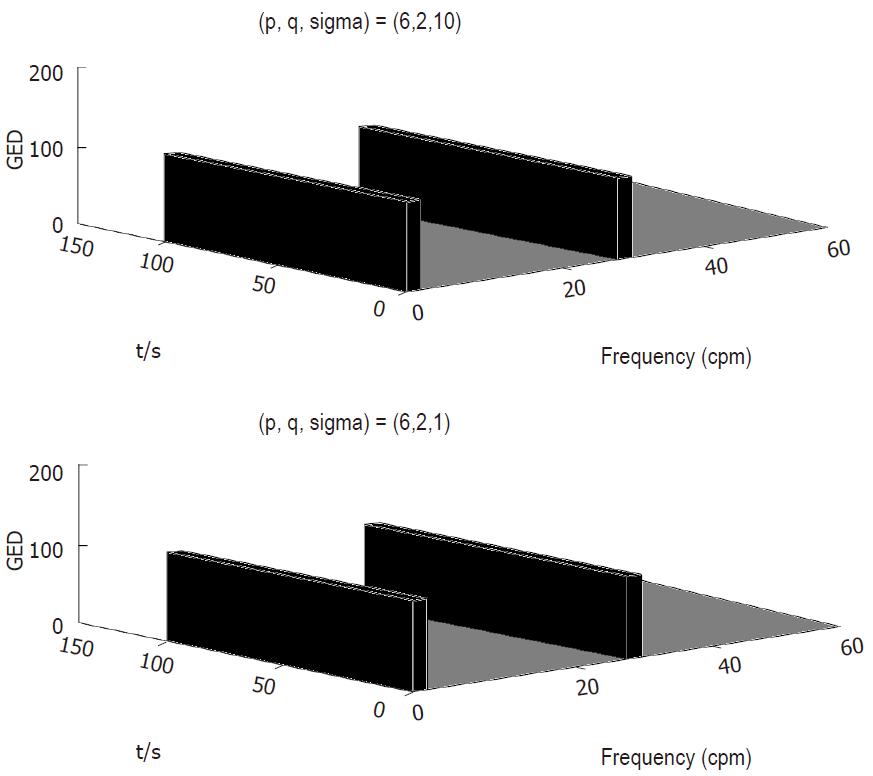Published online Sep 15, 1996. doi: 10.3748/wjg.v2.iSuppl1.125
Revised: January 11, 1996
Accepted: July 17, 1996
Published online: September 15, 1996
AIM: This abstract introduces our study work on Time-frequency Analysis of EGG Signals by Generalised Exponential Distribution (GED) and Butterworth Distribution (BUD), which aims at extracting more efficiently time-frequency characteristics from EGG signals with less cross-term interference, compared with Wigner Distribution.
METHODS: Now that the EGG signals are nonstationary, time-frequency representations (TFRs) becomes one of powerful tools used for analysing them. TFRs can be separated into two classes, i.e. linear TFRs and Quadratic TFRs. The well-known short-time Fourier transform (STFT), Gabor transform and newly proposed wavelet-transform (WT) belong to linear TFRs, while Wigner distribution (WD) and its smoothed versions, such as Chol William (exponential) disrtibution (CWD or ED) and its generalised version (GED) as well as Butterworth distribution (BUD) and so on belong to Quadratic TFRs. After making a profound investigation, we will focus on GED and BUD for our purpose. Quadratic Cohen class of distributions is defined as
Math 1
where ω = frequency, φ(ξ, τ) = kernel function, for example, φ(ξ, τ) = 1 corresponding to the WD, φ(ξ, χ) = e-(ξ2τ2/σ) to the ED. Different kernel functions provide different properties to suppress cross-terms. We will focus on the two cases in which φ(ξ, τ) = e-ξpτq/σ
corresponding to the GED and φ(ξ, τ) = 1/(1 + ξpτq/σ ) to the BUD (p, q = even integer), because the two distributions have better properties than WD or ED in suppressing cross-terms and our investigations show that they are suitable for EGG signals. The discrete version of Cohen class of distributions described above is given by
Math 2
The effects of the TFR parameters are crucial to the analysed results. We have investigated how to best or adaptively choose GED or BUD parameters to mach the EGG signals. Figure 1 shows that larger P or smaller σ will provide better property in suppressing cross-terms. But smaller σ will scarify resolution to reduce the magnitude of these same cross-terms. For our applications, σ = 0.1-1.0 is a better trade-off range. It is easily seen by comparing with ED that the property of the GED is better than that of the ED in suppressing corss-terms. The properties of the BUD approach the GED in trade-off between suppressing cross-terms and resolution, but the BUD has a closed representation while it is difficult to derive such a representation for the GED especially when p or q becomes larger. The some practical TFR simulations are performed by using BUD on the clinically recorded EGG signals and the same conclusion can be drawn.
- Citation: Wang ZS, Li WH, He ZY, Chen JZ, Liang J. Time-frequancy analysis of EGG signals by using GED and BUD. World J Gastroenterol 1996; 2(Suppl1): 125-125
- URL: https://www.wjgnet.com/1007-9327/full/v2/iSuppl1/125.htm
- DOI: https://dx.doi.org/10.3748/wjg.v2.iSuppl1.125
Original title:
E- Editor: Liu WX











